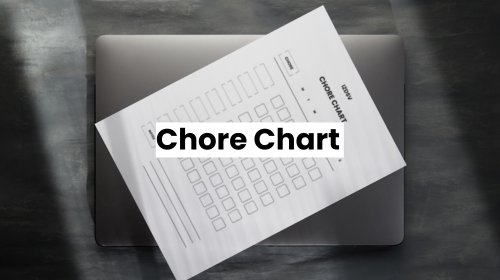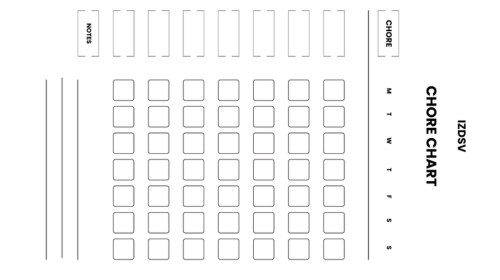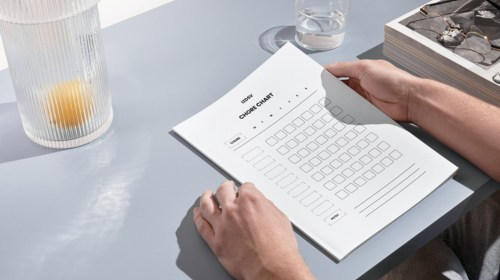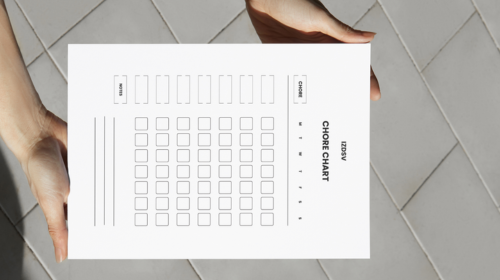Customizable vs. Pre-Made Weekly Chore Charts
What are the Benefits of Using a Customizable Chore Chart?
A customizable chore chart is a powerful tool for organizing household responsibilities and promoting accountability among family members. By tailoring the chart to specific needs, families can create a more efficient and engaging system for managing household tasks.
Benefits include:
- Establishes clear expectations for each family member by visually outlining specific responsibilities and deadlines
- Promotes a sense of shared responsibility and teamwork within the household
- Helps develop important life skills like time management, discipline, and task completion
- Reduces household conflicts by providing a transparent and fair task distribution method
- Provides a sense of accomplishment and boosts self-esteem as tasks are completed and tracked
- Creates a structured routine that can help reduce stress and mental load for all family members
How can a personalized chore chart help children?
A personalized chore chart serves as an excellent educational tool for teaching children important life skills and responsibilities. By involving children in household tasks through a customized chart, parents can foster independence, discipline, and a sense of contribution.
Benefits for children are:
- Develops critical life skills such as time management, organization, and personal accountability
- Builds self-confidence through visible achievements and task completion
- Teaches the value of contributing to family responsibilities
- Helps children understand the importance of routine and consistent effort
- Provides a structured way to learn task sequencing and prioritization
- Encourages intrinsic motivation through positive reinforcement and visual tracking of progress
What features make a custom chore chart more effective?
An effective chore chart goes beyond a simple list of tasks and incorporates elements that engage and motivate family members. Customization and thoughtful design are key to creating a chart that truly supports household management.
Key features:
- Age-appropriate tasks that match each family member’s capabilities and skill level
- Flexibility to adjust tasks based on changing schedules and responsibilities
- Visual appeal with colors, stickers, or graphics that make tracking enjoyable
- Built-in reward systems or incentive structures to motivate task completion
- Digital or physical tracking options that suit the family’s preference
- Clear and specific task descriptions to avoid confusion
- Options for rotating or sharing tasks to prevent monotony and promote fairness
How to customize a chore chart for your household tasks?
Creating a personalized chore chart requires careful consideration of your family’s unique needs, schedules, and dynamics. A successful approach involves collaboration and a willingness to adapt the system as your family’s needs evolve.
Steps to customize:
- Conduct a family meeting to discuss and list all necessary household tasks
- Assess each family member’s age, abilities, and available time
- Assign tasks equitably, considering individual strengths and limitations
- Create a clear, easy-to-understand visual representation of the chart
- Implement a tracking system, such as stickers, checkmarks, or digital apps
- Set realistic expectations and be prepared to adjust the chart periodically
- Include a mechanism for accountability and potential rewards
- Make the chart interactive and engaging for all family members
Why Choose a Pre-Made Weekly Chore Chart?
A pre-made weekly chore chart offers a convenient and professionally designed solution for household task management. These ready-to-use templates provide an immediate organizational tool that can streamline household responsibilities without the need for creating a chart from scratch.
Advantages:
- Eliminates the time-consuming process of designing a chore chart from scratch
- Provides a professionally structured layout that covers most common household tasks
- Offers a tested and proven system for task distribution and tracking
- Reduces decision fatigue by presenting a clear, pre-organized framework
- Includes professional design elements that make task tracking more visually appealing
- Provides instant accessibility for families looking to improve their household management
What are the advantages of using a printable chore chart?
Printable chore charts offer a flexible and accessible solution for managing household tasks across different family contexts. These versatile tools provide an easy-to-implement system that can be quickly adapted to various household needs.
Benefits include:
- Allows for immediate implementation without complex setup
- Can be easily printed multiple times or customized with handwritten additions
- Provides a tangible, physical tracking method that can be displayed prominently
- Offers a cost-effective alternative to digital or specialized tracking systems
- Enables quick modifications and adjustments by hand
- Creates a visual reminder of tasks that increases accountability
- Supports different learning and tracking styles, especially for children
How can a chore chart template save you time?
A pre-designed chore chart template significantly reduces the time and mental energy required to create an organizational system from scratch. These templates leverage proven design principles and task management strategies to provide an efficient solution.
Time-saving aspects are:
- Eliminates hours of planning and designing a custom tracking system
- Provides a ready-to-use framework that can be implemented immediately
- Reduces cognitive load by presenting a structured task management approach
- Offers pre-categorized task sections that cover the most common household responsibilities
- Minimizes decision-making time by presenting a clear, organized template
- Allows for quick customization without starting from a blank page
- Provides a professional layout that requires minimal additional preparation
Where can I find free chore chart options?
Numerous online resources offer free chore chart templates that cater to different family structures and organizational needs. These resources provide accessible solutions for families looking to improve their household task management without additional cost.
Free resource options are:
- Educational websites offering downloadable PDF templates
- Parenting blogs with free printable chore chart designs
- Pinterest boards dedicated to organizational tools and family management
- Family and lifestyle websites with comprehensive template libraries
- Microsoft Office and Google Docs template galleries
- Homeschooling and educational resource websites
- Social media platforms with downloadable organizational content
How to Track Progress with Chore Charts?
Tracking progress with chore charts is essential for maintaining accountability and ensuring consistent household task completion. An effective tracking method transforms a simple list of tasks into a motivational tool that encourages continuous participation and responsibility.
Methods for tracking progress:
- Using visual indicators like stickers, checkmarks, or color-coding to mark completed tasks
- Implementing a point or reward system that provides tangible recognition for task completion
- Creating a weekly review process where family members discuss their progress and challenges
- Displaying the chore chart in a prominent location to maintain visibility and accountability
- Utilizing digital tracking apps that provide real-time progress updates
- Establishing a consistent schedule for updating and reviewing the chore chart
- Incorporating a self-assessment component where individuals reflect on their task performance
What methods can help in tracking progress on chores?
Effective chore tracking requires a combination of systematic approaches and motivational techniques that make task completion engaging and rewarding. The right tracking method can transform chores from a mundane obligation to an interactive and satisfying experience.
Recommended tracking methods are:
- Developing a color-coded system where different colors represent task status (not started, in progress, completed)
- Creating a magnetic or dry-erase board that allows for easy updating and visual tracking
- Implementing a digital spreadsheet with automatic progress calculations
- Using smartphone apps specifically designed for household task management
- Establishing a weekly family meeting to review and discuss chore completion
- Incorporating a progress percentage tracker for ongoing or complex tasks
- Designing a visual progress bar or milestone system to show overall household task completion
How can a responsibility chart motivate kids to complete tasks?
A well-designed responsibility chart serves as a powerful motivational tool that encourages children to take ownership of their household duties. By making task completion visible, rewarding, and age-appropriate, these charts can transform chores into a positive learning experience.
Motivation strategies include:
- Creating a reward system with tangible incentives for consistent task completion
- Using age-appropriate graphics and design elements that make the chart visually appealing
- Involving children in the chart design process to increase their sense of ownership
- Implementing a progressive difficulty system that challenges children as they improve
- Providing immediate recognition through stickers, points, or verbal praise
- Breaking down tasks into manageable steps to prevent overwhelming children
- Connecting task completion to age-appropriate privileges or increased independence
What tools can enhance chore tracking?
Modern technology and creative design provide numerous tools that can significantly improve chore tracking and management. These tools range from digital applications to physical devices that make task monitoring more efficient and engaging.
Enhancing tracking tools:
- Smartphone apps with real-time progress tracking and notification systems
- Smart home devices that can integrate chore tracking with other household management systems
- Digital calendars with task assignment and completion tracking features
- Customizable spreadsheet templates with automatic progress calculations
- Interactive whiteboards or digital displays that update in real-time
- Wearable technology that can send task reminders and track completion
- Family management platforms that combine chore tracking with other organizational features
Can You Use a Chore Chart for Daily and Weekly Tasks?
Chore charts are versatile organizational tools that can effectively manage both daily and weekly household responsibilities. These flexible systems allow families to create comprehensive task management strategies that address both immediate and ongoing household maintenance needs.
Key aspects of daily and weekly chore charts are:
- Ability to track and organize tasks across different time frames and frequencies
- Flexibility to accommodate various household sizes and individual capabilities
- Opportunity to break down larger weekly tasks into manageable daily responsibilities
- Comprehensive approach to tracking household maintenance and individual contributions
- Clear visualization of task distribution and completion progress
- Adaptability to changing household routines and schedules
- Potential for creating long-term organizational habits
What is the difference between a daily chore chart and a weekly chore chart?
Daily and weekly chore charts serve distinct purposes in household management, each addressing different levels of task complexity and frequency. Understanding their unique characteristics helps families create more effective task management strategies.
Key differences:
- Daily chore charts focus on immediate, routine tasks like making beds, doing dishes, and quick cleanups
- Weekly chore charts address more comprehensive tasks such as laundry, deep cleaning, and household maintenance
- Daily charts provide a more granular view of ongoing responsibilities
- Weekly charts offer a broader perspective on household task distribution
- Daily charts help maintain consistent household cleanliness and order
- Weekly charts allow for more complex and time-consuming tasks
- Daily charts typically require more frequent updates and tracking
How to assign household responsibilities effectively?
Effective assignment of household responsibilities requires a strategic approach that considers individual capabilities, schedules, and fairness. A thoughtful distribution of tasks ensures that all family members contribute meaningfully to household maintenance.
Strategies for effective assignments are:
- Conduct a family meeting to discuss and inventory all necessary household tasks
- Assess each family member’s age, skills, and available time
- Match tasks to individual strengths and learning opportunities
- Create a rotating system to prevent task monotony
- Establish clear expectations and guidelines for task completion
- Provide appropriate training and support for new or challenging tasks
- Implement a fair and transparent task allocation method
- Consider individual schedules and potential barriers to task completion
What are the best practices for using a chore list template?
A chore list template can be a powerful tool for household organization when used strategically and consistently. Implementing best practices ensures that the template remains a helpful and motivating resource for all family members.
Best practices are:
- Choose a template that is visually appealing and easy to understand
- Customize the template to fit your specific household needs
- Use clear and specific task descriptions to avoid confusion
- Implement a consistent tracking and update system
- Ensure the template is accessible to all family members
- Review and adjust the template periodically
- Include a mechanism for recognizing and rewarding task completion
- Balance task complexity with individual capabilities
- Create age-appropriate sections for different family members
- Maintain flexibility to accommodate changing household dynamics
How to Create a Chore Chart for Kids?
Creating a chore chart for children is an excellent way to teach responsibility and develop important life skills. A well-designed chore chart can transform household tasks into an engaging and rewarding experience for kids.
Key considerations:
- Develop an age-appropriate chart that matches the child’s developmental stage and capabilities
- Use visual and interactive elements that make task tracking exciting and motivational
- Break down tasks into simple, manageable steps
- Incorporate clear instructions and expectations
- Create a system that provides positive reinforcement
- Ensure the chart is visually appealing and easy to understand
- Allow for some personalization to increase the child’s ownership and engagement
What elements should be included in a chore chart for kids template?
A comprehensive chore chart template for children should be both functional and motivational. The design should balance clear task assignment with elements that make tracking enjoyable and educational.
Essential elements are:
- The child’s name is prominently displayed at the top of the chart
- Clear, simple task descriptions using age-appropriate language
- Checkboxes or sticker spaces for marking completed tasks
- Different sections for daily, weekly, and occasional tasks
- Visual icons or graphics representing each task
- Space for tracking progress and accumulated rewards
- Color-coded sections to differentiate task types
- Difficulty level indicators for each task
- Sections for parental feedback or additional notes
How can you personalize a chore chart for your child’s name?
Personalization is key to making a chore chart more engaging and meaningful for children. By incorporating a child’s name and personal interests, the chart becomes a more motivating tool for task completion.
Personalization strategies include:
- Use large, colorful lettering for the child’s name at the top of the chart
- Include favorite cartoon characters or themes
- Select a background color or design that reflects the child’s preferences
- Create custom illustrations or graphics related to the child’s interests
- Use the child’s favorite fonts or handwriting styles
- Add personal motivational quotes or encouragement
- Include spaces for the child to add their own decorative touches
- Create a unique title like “[Child’s Name]’s Super Helper Chart”
What are some fun designs for a kids’ chore chart?
Designing a fun and attractive chore chart can significantly increase a child’s motivation and engagement with household tasks. Creative and playful designs can transform chore tracking from a mundane task to an exciting activity.
Enjoyable design ideas can be:
- Superhero-themed charts with tasks as “missions” to complete
- Colorful rainbow or unicorn-themed designs
- Adventure or treasure map-style tracking systems
- Cartoon character-inspired layouts
- Space or science fiction-themed charts
- Interactive designs with movable pieces or stickers
- Game-inspired tracking systems with level-ups and achievements
- Nature and animal-themed charts
- Seasonal designs that change throughout the year
- Personalized charts featuring the child’s artwork or photos
What Are the Best Tools for Customizing Your Chore Chart?
Creating a personalized chore chart requires the right tools and resources to make task tracking engaging and effective. With numerous digital and physical options available, families can find versatile solutions to meet their specific household management needs.
The top customization tools are:
- Digital design platforms like Canva and Notion for creating printable charts
- Specialized chore chart apps with customizable templates
- Graphic design software for creating unique, personalized layouts
- Online template libraries with extensive customization options
- Whiteboard and magnetic chart systems for flexible tracking
- Tablet and smartphone applications with interactive features
- Printable PDF templates that can be modified and personalized
- Craft and stationery supplies for handmade, creative chart designs
How to use Canva to create a chore chart?
Canva offers a user-friendly platform for designing custom chore charts with professional-looking results. This versatile design tool provides numerous templates and customization options for creating personalized task tracking systems.
Step-by-step Canva creation process:
- Sign up for a free Canva account or log in to an existing profile
- Search for “chore chart” or “task tracker” in the template library
- Select a template that matches your desired style and layout
- Customize the template by changing colors, fonts, and background
- Add family members’ names and specific task categories
- Insert icons or graphics to represent different chores
- Adjust the layout to fit your household’s specific needs
- Download or print the completed chore chart
- Save the design for future modifications or reprinting
What are the benefits of a dry-erase chore chart?
Dry-erase chore charts offer a flexible and reusable solution for tracking household tasks and responsibilities. These versatile tools provide an interactive and easily updatable method for managing daily and weekly chores.
Key advantages are:
- Ability to quickly update and modify tasks without reprinting
- Environmentally friendly alternative to disposable paper charts
- Provides a visual and tactile tracking experience
- Easily mounted in high-traffic areas of the home
- Allows for immediate changes and real-time task management
- Durable and long-lasting compared to paper alternatives
- Supports multiple tracking methods like color-coding and symbols
- Cost-effective solution for ongoing household organization
What features should you look for in a customizable chore chart?
A truly effective chore chart goes beyond basic task listing and incorporates features that enhance motivation, tracking, and household management. The right combination of elements can transform a simple chart into a powerful organizational tool.
Essential features:
- Flexible layout that accommodates different family sizes and structures
- Clear, legible design with easy-to-read task descriptions
- Options for digital or physical tracking
- Reward or incentive tracking system
- Age-appropriate task categorization
- Ability to rotate or reassign tasks
- Space for individual notes and progress tracking
- Compatible with multiple devices or display methods
- Customizable color schemes and visual elements
- Sections for different types of tasks (daily, weekly, monthly)
- Easy-to-update format that reduces administrative effort
- Integration with digital calendars or family management apps




